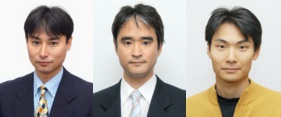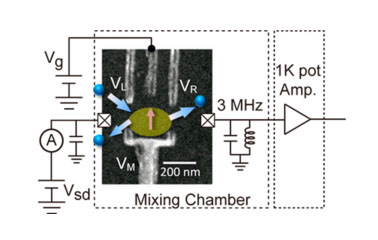Assoc Prof Kobayashi, Kensuke and Rearch Group, “Collision Experiment on a Chip: Scattered by the Kondo Cloud” (Published in Physical Review Letters, 26 April 2011)
|
Collision Experiment on a Chip: Scattered by the Kondo Cloud “Evolution of the Kondo Effect in a Quantum Dot Probed by the Shot Noise”
Published in Physical Review Letters , 106, 176601 (26 April 2011) |

Prof. ONO T, Assoc Prof. KOBAYASHI K, and Program-Specific Assist Prof. SEKIGUCHI, K |
| Yoshiaki Yamauchi1, Koji Sekiguchi1, Kensaku Chida1, Tomonori Arakawa1, Shuji Nakamura1, Kensuke Kobayashi1, Teruo Ono1, Tatsuya Fujii2, Rui Sakano3 | |
| 1Institute for Chemical Research, Kyoto University, Uji, Kyoto, Japan. 2Institute for Solid State Physics, University of Tokyo, Kashiwa, Chiba, Japan. 3Department of Applied Physics, University of Tokyo, Hongo, Tokyo, Japan. |
|
| The Kondo effect is one of the most fundamental many-body phenomena in condensed matter physics. Conventionally, the Kondo effect is detected through the characteristic temperature dependence of the resistance or the magnetization of the system. Such properties tell us how a local spin interacts with continuum to form a correlated ground state, namely “Kondo cloud“, in lowering the temperature. However, the Kondo effect in an artificial atom or quantum dot (QD) fabricated on the semiconductor surface offers a new attractive stage to address Kondo physics in a way otherwise impossible. | |
| Here we show that the shot noise at the Kondo QD successfully signals the evolution of the Kondo correlation due to the electron scattering via the Kondo cloud. When the Kondo correlation evolves, the electron scattering that involves several electrons starts to occur. This enhances the shot noise in the Kondo QD more than that in the noninteracting case. Such an experiment can be viewed as “collision experiments” on a chip and will shed new light on Kondo physics. | |
 |
Figure: The scanning electron microscope image of the artificial atom (yellow) with a measurement schematic. The single spin inside the atom (indicated by the arrow) causes the Kondo effect. We measure the electron scattering by the Kondo state. |
| This work is partially supported by KAKENHI and Yamada Science Foundation. | |
 Institute for Chemical Research, Kyoto University
Institute for Chemical Research, Kyoto University International Joint Usage Research Center
International Joint Usage Research Center